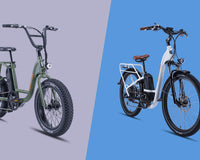There’s no better way to enjoy summer than with an ebike. Whether you’re visiting with old friends for the first time in ages or swinging by some of your favorite lunch spots, it’s a safe bet that you’ll be spending a lot of time on two-wheels.
With all of the summer adventures ahead of you, here’s a few tips to help keep your battery healthy—and keep you up and riding all summer long.
Protect Your Battery From Direct Sunlight

You might like soaking up the rays, but your battery’s less enthusiastic. Avoid leaving it in direct sunlight for more than an hour.
While we always recommend storing your bike inside, if that is not possible, detach the battery and store it in a cool, dry place away from direct sunlight, dirt, debris, high temperatures, and corrosive household items.
When it comes time to charge your battery, always keep it away from direct sunlight and high temperatures. Find a spot indoors that’s shaded and between 50 °F–77 °F.
These simple steps can help maintain your battery's lifespan. Extreme temperatures can wear down the components that are used to generate power for your ebike, leading to premature capacity loss.
Don't Ride in Extreme Heat
To keep your battery healthy and preserve its range per charge, avoid riding your ebike when it’s above 113 °F.
Like a lot of electronics, including most cell phones, your battery will protect itself from overheating by shutting down when it’s too hot. If this happens to you, don’t panic. This is part of its normal protection controls and happens when the internal temperature rises above 140 °.
Before normal use can continue, it will need to cool down. Take the battery to an indoor environment, ideally one that’s between 50 °F–77 °F, for roughly one hour.
Avoid Salt and Saltwater

You may find a bit of ocean spray on a summer day refreshing, but it’s bad for your battery.
Salt has corrosive properties and high electrical conductivity. As such, we advise against riding your ebike in areas where you’re likely to encounter salt and saltwater, like directly on the beach.
However, if you do come across salt or saltwater, there are steps you can take to help minimize any damage to your bike or battery.
Remove your battery, wipe down the battery case and battery tray with a clean dry rag, and ensure the connections are dry and clean. Then use a clean rag dampened with fresh water to clean the bike frame and mechanical components and let them dry completely before putting the battery back on. Make sure to avoid spraying water directly into electrical components, like your display or battery tray.
Regular maintenance, like lubricating your chain, is always important but should be practiced more frequently when there’s the possibility of salt or saltwater exposure.
Pro tip: We know it’s sometimes difficult to detect exposure, but you can generally tell when the bike has encountered salt or saltwater by the white, chalky residue that salt leaves behind.
Inspect Your Battery Regularly
Check the battery terminals for signs of corrosion, which can look like a green dust or film, and make sure that the battery is merely warm to the touch during charging and not hot, which is a likely sign of damage.
Before you ride, inspect the battery to ensure that it is securely locked to the frame.
If your battery does need to be replaced, make sure that you purchase the right replacement battery for your model directly from Rad Power Bikes, as they were built with extra durability in mind, and Rad battery and charger are designed to work together seamlessly.
Switching it up and using third-party batteries or chargers could result in the battery being charged too fast or losing capacity. Too much heat can land your battery in trouble, including major, irreparable damage.
Travel Smart

Have you ordered our all-new RadRover 6 Plus? A Battery Terminal Cover is an easy way to safeguard your bike's connections on long trips.
Who wouldn’t want to bring their electric bike on a road trip? When you strap yours to a bike rack or place it in the back of a truck bed, remove the battery as an added safeguard against the elements and by removing the battery you remove roughly 7 pounds of bike weight, too.
For extra peace of mind, store your battery in our all-new Battery Travel Case—it fits your battery, charger and spare set of keys.
Got all that? When used as directed, your ebIke battery can provide years of reliable power. Just remember to avoid extreme weather, direct sunlight, and salt or saltwater wherever possible. And, as always, don’t forget to take your battery off when transporting your bike in the open-air and always keep an eye out for the first signs of damage.
For additional information, check out these tips on maximizing your battery life, riding in warm weather, and our comprehensive online help center. And to safeguard your battery when you're on the go, check out our new Battery Travel Case.






